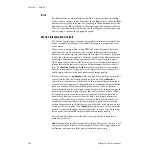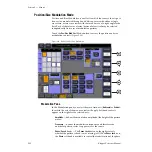
304
Kalypso Reference Manual
Section 3 — Menus
Blur
The Blur feature is only available on Kalypso Classic systems. Incoming
video on these systems can be blurred with the
Blur
controls. When the
Blur
button is active (green indicator on), touching the Blur data pad below the
button activates a Blur soft knob on the upper right. The amount of blur (0-
100%) is controlled by the soft knob or by touching the soft knob data pad
and entering a value with the popup keypad.
Motion Interpolation Controls
The Motion Interpolation controls only apply to interlaced formats, and so
are not available on Kalypso HD systems running in a progressive scan
video mode.
When video is manipulated in any DPM, the video data must be resam-
pled, and new pixels will need to be created. Interlaced video displays
alternate lines from slightly different points in time. When there is motion
in the video, the pixels in the two fields of a frame will be different because
of this time differential. When interlaced video is processed through a
DPM, undesirable artifacts (like flicker) can occur. Motion detection and
interpolation techniques exist that can help minimize these motion arti-
facts. The
Adaptive
,
Frame
, and
Field
interpolation controls lets you adjust
how the interpolation of the pixels is accomplished, which can result in
subtle improvements in the final transformed image quality.
In almost all cases, using
Adaptive
with the default threshold gives excellent
overall results, and this setting should be tried first. When
Adaptive
is
selected, motion detection is activated. In this mode, different techniques
are used to create new pixels, depending on how subsequent pixels differ
from one another. When the sampled pixels are the same (no motion)
Frame interpolation is used, which creates new pixels by interpolating both
fields of the interlaced frame and provides full vertical resolution. When
the sampled pixels are different (motion present), Field interpolation is
used, which creates new pixels from the fields, resulting in minimized
motion artifacts but a lower vertical resolution. Both these methods are
employed at the same time in the same image, so picture areas lacking
motion are presented in full resolution, and only areas with motion are pro-
cessed at lower resolution. The
Threshold
controls are used to set how much
motion is required to trigger field interpolation. In some cases, adjusting
the adaptive threshold can improve transformed image quality.
You can disable motion detection and force a particular interpolation
method if you wish.
Frame
interpolation disables motion detection and forces the creation of all
new pixels from both fields of the interlaced frame. This is appropriate for
still images and provides full vertical resolution processing.
Содержание Grass Valley Kalypso Classic
Страница 1: ...Kalypso VIDEO PRODUCTION CENTER Reference Manual SOFTWARE VERSION 11 0 071817605 MARCH 2005...
Страница 54: ...54 Kalypso Reference Manual Section 1 System Overview...
Страница 364: ...364 Kalypso Reference Manual Section 3 Menus...
Страница 404: ...404 Kalypso Reference Manual Index...
















































